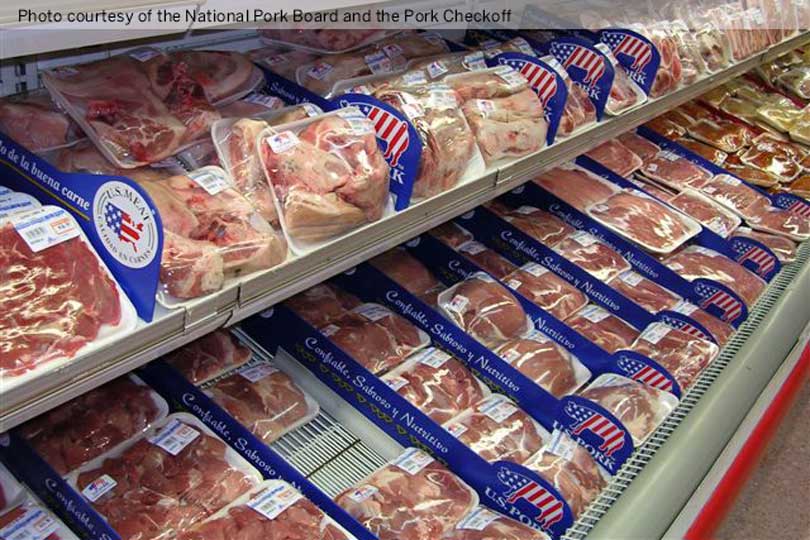By Jessica Domel
Multimedia Reporter
Several organizations are expressing concerns for American hog farmers following a month of lower exports and increased global tariffs.
“We now face large financial losses and contraction because of escalating trade disputes,” Jim Heimerl, president of the National Pork Producers Council and a hog farmer from Johnstown, Ohio, said. “That means less income for pork producers and, ultimately, some of them going out of business.”
Earlier this month, U.S. President Donald Trump authorized a 25 percent tariff on $34 billion of Chinese goods following an investigation into Chinese trade and intellectual property practices.
The same day, China retaliated with equal tariffs on U.S. goods, including pork products.
U.S. pork farmers now face 62 percent tariffs in China, which represented a 17 percent share of total U.S. exports by value in 2017.
“America’s pig farmers and their families are patriots who are demonstrating enormous commitment to the greater good of our country as they shoulder a disproportionate share of trade retaliation against the United States,” Heimerl said. “We need these trade disputes to end.”
Prior to the trade dispute, China already had a 12 percent tariff on U.S. pork. An additional 25 percent tariff was levied in April followed by the 25 percent retaliatory tariff announced in July.
“The people that are being hit a lot really are pork producers. We sell over a billion dollars a year of pork to China,” Dave Salmonsen, senior director of Congressional Relations for the American Farm Bureau Federation, said in an interview with the Texas Farm Bureau (TFB) Radio Network.
As a result of the United States’ 10 percent tariff on imported aluminum and 25 percent tariff on imported steel, Mexico implemented a series of tariffs on pork products in June and July.
A 10 percent tariff on frozen and fresh pork muscle cuts, a 15 percent duty on pork sausages and a 20 percent tariff on some prepared hams went into effect in June.
The 10 percent tariff on frozen and fresh pork muscle cuts rose to 20 percent July 5.
Mexican officials also opened a duty-free quota to attract pork exports from other countries.
Salmonsen said there is a concern these tariffs will make prices so high buyers will look to other countries for pork products.
Before the tariffs went into effect, pork exports were down two percent from May 2017 to 217,209 metric tons valued at $562.5 million.
Despite the decrease, pork export volume from January through May was three percent higher than last year’s record pace at 1.08 million metric tons, according to the U.S. Meat Export Federation (USMEF).
The value of exports from January through May was up six percent to $2.85 billion.
During the first five months of this year, U.S. pork producers exported six percent more pork than last year at 353,264 metric tons. The exports were valued at $621 million.
Pork exports to China were down 18 percent between January and May.
According to the USMEF, pork exports will face an even steeper challenge in the second half of 2018.
“It is unfortunate that U.S. pork is caught in the crosshairs of a dispute that has nothing to do with pork trade,” Dan Halstrom, USMEF president and CEO, said. “USMEF is focusing on the factors we can control by partnering with U.S. packers and exporters to make every effort to defend our market share and protect our business in Mexico and China. USMEF also consistently stresses the importance of diversifying our export markets and expanding U.S. pork’s footprint into emerging markets, and those efforts are more critical than ever.”
The news is not all bad for pork producers. USMEF reports South Korea is a destination for U.S. pork. May exports were up 44 percent from 2017 to 22,447 metric tons valued at $64.4 million. From January through May, more than 117,000 metric tons of pork was exported to Korea.
Other buyers of U.S. pork from January through May:
- Japan: 167,294 metric tons


Numbers reported do not lend credence to the the complaints registered. It is about time someone stood up to China and the sporadic Mexican economy should not have anyone concerned.
I agree. The US producers have been thrown scraps in the past & now we have an administration wanting to get our trade inbalance back in line with other countries like China & Mexico. Naturally Agriculture is going to be carrying a big part of the burden.